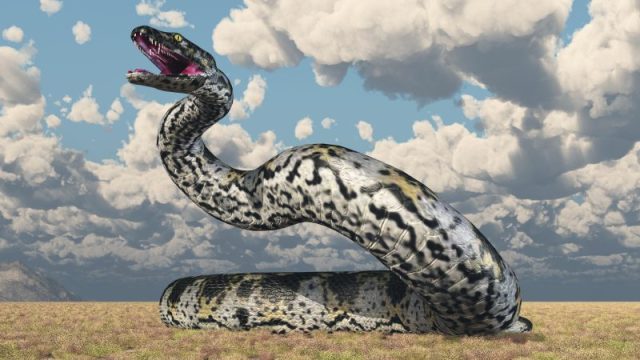Jurassic Nightmares: 5 Prehistoric Monsters We're Glad Stayed Extinct
Science
2025-04-08 18:10:10Content

Imagine a prehistoric predator standing over 10 feet tall, with a massive beak capable of delivering bone-crushing strikes. These weren't mythical creatures, but real-life prehistoric birds known as "terror birds" that once dominated the landscapes of South America millions of years ago.
Phorusrhacids, commonly called terror birds, were flightless predators that ruled the continent during the Cenozoic era. Unlike modern birds, these massive creatures were apex predators with incredible hunting capabilities. Their powerful legs allowed them to chase down prey at remarkable speeds, while their enormous beaks served as deadly weapons.
These prehistoric hunters thrived between 62 million and 2 million years ago, evolving into some of the most formidable carnivorous birds in Earth's history. The largest species, such as Titanis walleri, could weigh up to 330 pounds and stood taller than many human adults.
Scientists believe these terror birds used a unique hunting strategy, using their incredible speed and powerful beaks to stun and kill prey. Their muscular necks enabled them to deliver devastating strikes, making them incredibly efficient predators in their ancient ecosystem.
While they eventually went extinct, terror birds represent a fascinating chapter in evolutionary history, showcasing the incredible diversity and adaptability of prehistoric wildlife. Their legacy continues to captivate paleontologists and wildlife enthusiasts alike, offering a glimpse into a world dramatically different from our own.
Prehistoric Predators: Unraveling the Enigma of South America's Feathered Killers
In the vast and untamed landscapes of prehistoric South America, a group of extraordinary predators once roamed, striking fear into the hearts of their prey. These remarkable creatures, known as "terror birds," represent one of the most fascinating chapters in the evolutionary history of terrestrial predators, challenging our understanding of prehistoric ecosystems and the incredible diversity of life that once inhabited our planet.Discover the Terrifying Hunters That Dominated Ancient Landscapes
The Rise of Prehistoric Avian Predators
The emergence of terror birds, scientifically known as Phorusrhacids, marks a remarkable evolutionary phenomenon that captivates paleontologists and wildlife enthusiasts alike. These flightless birds evolved to become apex predators, developing extraordinary adaptations that made them formidable hunters in the prehistoric South American landscape. Standing up to three meters tall, these massive avian carnivores possessed powerful legs, razor-sharp beaks, and a hunting strategy that would make modern predators seem almost timid by comparison. Their unique anatomical structure allowed them to pursue prey with incredible speed and precision. Unlike contemporary birds, terror birds had evolved into ground-dwelling killing machines, with muscular legs that enabled them to chase down victims across vast open terrains. The specialized skull structure, featuring a massive, hook-like beak, provided them with unparalleled hunting capabilities, capable of delivering fatal blows with devastating efficiency.Evolutionary Adaptations of Nature's Most Terrifying Prehistoric Hunters
The terror birds represented a pinnacle of evolutionary adaptation, demonstrating how environmental pressures can transform seemingly innocuous creatures into extraordinary predators. Their skeletal structure revealed remarkable modifications that distinguished them from other prehistoric fauna. Powerful leg muscles, reinforced bone structures, and a unique biomechanical design allowed these birds to become the dominant predators of their time. Researchers have discovered multiple species within the Phorusrhacid family, each with distinct characteristics that showcased the incredible diversity of these prehistoric hunters. Some species specialized in hunting smaller prey, while others were capable of taking down significantly larger mammals. Their hunting techniques varied, ranging from ambush strategies to prolonged pursuit, demonstrating a level of predatory intelligence that continues to fascinate scientific communities.Ecological Impact and Environmental Significance
The presence of terror birds fundamentally reshaped our understanding of prehistoric ecosystems. These magnificent creatures played a crucial role in maintaining ecological balance, controlling prey populations and influencing the evolutionary trajectories of numerous species. Their existence provides critical insights into the complex interactions that defined ancient South American landscapes. Fossil evidence suggests that terror birds occupied diverse habitats, from grasslands to forested regions, adapting their hunting strategies to suit different environmental conditions. Their ability to thrive in multiple ecosystems underscores their remarkable evolutionary success and highlights the intricate relationship between predators and their surrounding environments.Scientific Discoveries and Ongoing Research
Modern paleontological research continues to unveil new information about these extraordinary creatures. Advanced technological methods, including sophisticated imaging techniques and genetic analysis, are providing unprecedented insights into the biology, behavior, and evolutionary history of terror birds. Interdisciplinary research teams are working tirelessly to reconstruct the complex narratives surrounding these prehistoric predators. By examining fossilized remains, analyzing geological contexts, and employing cutting-edge computational models, scientists are gradually piecing together the intricate puzzle of terror birds' existence and eventual extinction.Legacy and Evolutionary Significance
The story of terror birds extends far beyond mere prehistoric curiosity. These remarkable creatures represent a testament to the incredible diversity and adaptability of life on our planet. Their evolutionary journey provides crucial insights into the mechanisms of natural selection, demonstrating how environmental challenges can drive remarkable transformations in species. By studying terror birds, researchers gain valuable perspectives on evolutionary processes, predator-prey dynamics, and the complex interplay of biological adaptation. Their legacy continues to inspire scientific exploration and challenge our understanding of prehistoric life, reminding us of the extraordinary narratives hidden within the fossil record.RELATED NEWS
Science

Science Spectacular: COSI Unleashes Full STEAM Ahead in Blockbuster Festival Weekend
2025-04-28 10:00:29
Science

Silent Ambitions Silenced: How Budget Cuts Derailed Deaf Students' STEM Dreams
2025-04-28 21:07:08






